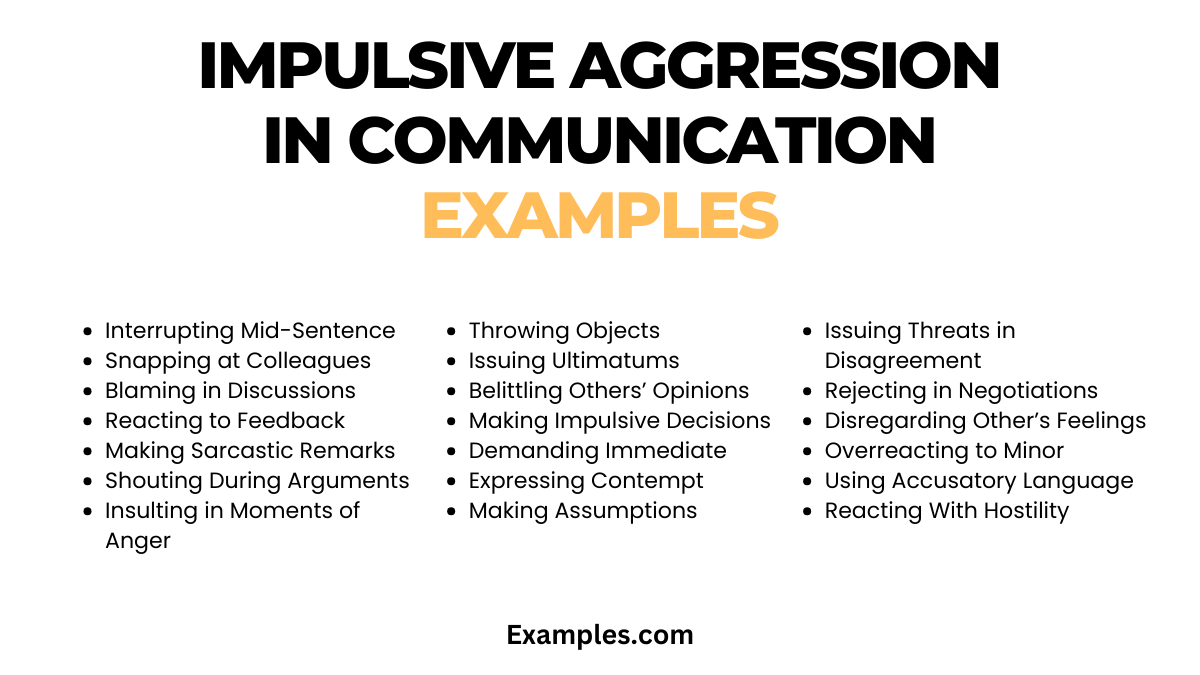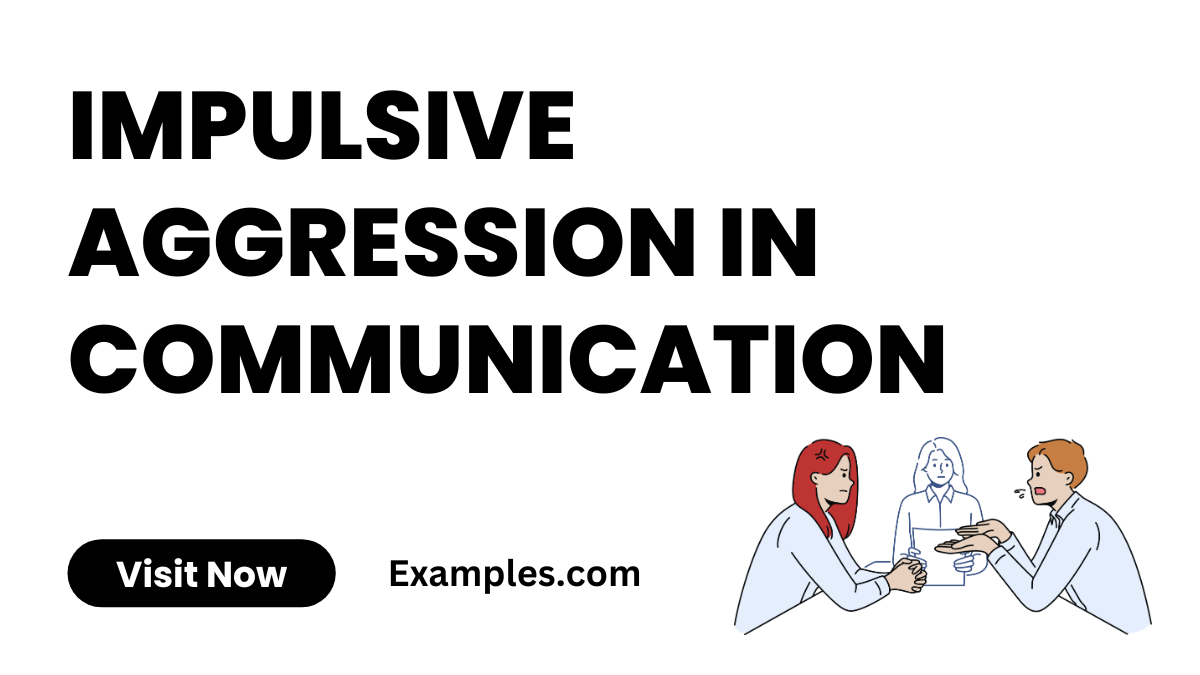Impulsive Aggression in Communication
Impulsive aggression in communication often emerges spontaneously, driven by intense emotions rather than deliberate intent. This comprehensive guide delves into the nuances of such behavior, providing real-world examples to illustrate how impulsive aggression manifests in various interactions. By understanding its characteristics and underlying causes, individuals can learn effective strategies to manage and respond to impulsive aggressive communication. This guide aims to empower readers with knowledge and techniques to navigate these challenging scenarios, promoting healthier and more constructive communication in personal and professional relationships.
What is Impulsive Aggression in Communication?

Impulsive aggression in communication refers to sudden and intense verbal outbursts that are often disproportionate to the situation. This type of aggression is characterized by spontaneous, unpremeditated reactions, where individuals may express anger or frustration in an explosive manner. These outbursts can include shouting, harsh words, or threatening language. Impulsive aggression typically lacks forethought and is driven more by emotional responses than rational thinking. Understanding and managing such impulsive reactions are essential for maintaining healthy and respectful communication.
20 Impulsive Aggression in Communication Examples

Impulsive aggression in communication manifests in various forms, often leading to confrontational and disruptive interactions. This list provides 20 examples, each accompanied by an explanation and example sentences, showcasing the diverse ways impulsive aggression can occur in everyday conversations.
- Interrupting others mid-sentence: Demonstrating a lack of patience and respect, often accompanied by raising one’s voice to dominate the conversation.
- Snapping at colleagues for minor mistakes: Overreacting to small errors with harsh criticism or anger, indicating a lack of emotional control.
- Blaming others in heated discussions: Quickly pointing fingers without assessing the situation calmly, often leading to unwarranted accusations.
- Reacting defensively to constructive feedback: Responding to helpful suggestions with hostility or denial instead of openness to improvement.
- Making sarcastic remarks in tense situations: Using biting sarcasm as a defense mechanism during conflicts, which can escalate tensions.
- Shouting during arguments: Resorting to loud, aggressive vocal tones to overpower others in a disagreement.
- Insulting others in moments of anger: Lashing out with personal attacks or offensive comments during heated exchanges.
- Slamming doors or throwing objects: Physically expressing anger in a way that intimidates others.
- Issuing ultimatums without discussion: Forcing decisions upon others without considering their input or perspectives.
- Mocking or belittling others’ opinions: Dismissing or ridiculing others’ viewpoints impulsively, without considering their validity.
- Making impulsive decisions during conflicts: Hastily making choices in the heat of the moment, often leading to regrettable outcomes.
- Demanding immediate responses in conversations: Exhibiting an unreasonable need for instant replies, indicating a lack of patience.
- Expressing contempt through body language: Rolling eyes, smirking, or using dismissive gestures during discussions.
- Making assumptions without clarifying: Jumping to conclusions about others’ intentions or actions without seeking clarification.
- Issuing threats in a disagreement: Resorting to intimidation tactics to get one’s way in an argument.
- Rejecting compromise in negotiations: Unwillingness to consider middle ground solutions in conflict resolution.
- Disregarding others’ feelings in conversations: Showing insensitivity or indifference to how one’s words affect others.
- Overreacting to minor inconveniences: Displaying disproportionate anger or frustration over small issues.
- Using accusatory language unnecessarily: Employing a blaming tone even in neutral situations, creating a hostile environment.
- Reacting with hostility to surprises or changes: Showing aggressive resistance to unexpected changes or new ideas.
What are the Causes of Impulsive Aggression in Communication?
Impulsive aggression in communication can arise from various underlying causes. Understanding these factors is crucial in addressing and managing this behavior effectively.
- Emotional Dysregulation: One primary cause of impulsive aggression is emotional dysregulation. When individuals struggle to manage their emotions, they may lash out impulsively in moments of anger, frustration, or anxiety. These intense emotions can trigger aggressive responses.
- Past Trauma: Individuals with a history of trauma or abuse may exhibit impulsive aggression as a coping mechanism. Traumatic experiences can leave lasting emotional scars, making it challenging to respond calmly to stressors.
- Impaired Impulse Control: Impaired impulse control, often associated with certain mental health conditions like borderline personality disorder or ADHD, can contribute to impulsive aggression. Difficulty in pausing and considering consequences can lead to impulsive outbursts.
- Substance Abuse: The misuse of substances, including alcohol and drugs, can lower inhibitions and impair judgment, increasing the likelihood of impulsive aggression during communication.
- Socialization Patterns: Unhealthy socialization patterns learned during childhood can influence aggressive behavior in adulthood. Growing up in an environment where aggression is normalized can lead to its perpetuation in communication.
- Environmental Stressors: External stressors such as financial difficulties, work-related pressures, or relationship conflicts can trigger impulsive aggression. These stressors can overwhelm individuals, leading to impulsive reactions.
- Lack of Coping Skills: Insufficient coping skills can make it challenging to handle life’s challenges effectively. When individuals lack healthy coping mechanisms, they may resort to impulsive aggression as a way to manage stress.
Tips for Effective Treatment for Impulsive Aggression in Communication
Treating impulsive aggression in communication requires a multifaceted approach, considering the underlying causes and individual needs. Here are some tips for effective treatment:
- Psychotherapy: Therapy, such as cognitive-behavioral therapy (CBT) or dialectical-behavior therapy (DBT), can help individuals develop emotional regulation skills, address past trauma, and improve impulse control.
- Medication: In cases where impulsivity is linked to underlying mental health conditions, medication prescribed by a mental health professional can help manage symptoms and reduce impulsive behavior.
- Anger Management: Anger management programs teach individuals healthy ways to cope with anger and frustration, replacing impulsive aggression with constructive responses.
- Substance Abuse Treatment: If substance abuse is a contributing factor, seeking treatment for addiction is essential to address the root cause of impulsive behavior.
- Stress Reduction Techniques: Learning stress-reduction techniques, such as mindfulness and relaxation exercises, can help individuals manage stressors effectively and reduce impulsive reactions.
- Healthy Communication Skills: Therapy can also focus on improving communication skills, teaching individuals how to express themselves assertively and respectfully rather than impulsively.
- Supportive Networks: Building a supportive network of friends and family can provide emotional support and encouragement during the treatment process.
Effective treatment for impulsive aggression in communication often involves a combination of these strategies tailored to the individual’s unique circumstances and needs. Seeking professional help is a crucial step in addressing and managing this challenging behavior.
In conclusion, impulsive aggression in communication, marked by spontaneous and emotionally-driven reactions, can significantly impact interpersonal dynamics. Understanding and managing this type of aggression is crucial for maintaining respectful and effective communication. It involves recognizing emotional triggers, practicing self-control, and developing strategies for constructive expression. Addressing impulsive aggression can lead to healthier interactions, both personally and professionally, fostering a more understanding and empathetic communication environment.



